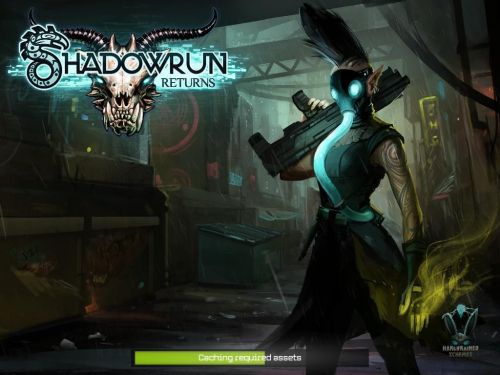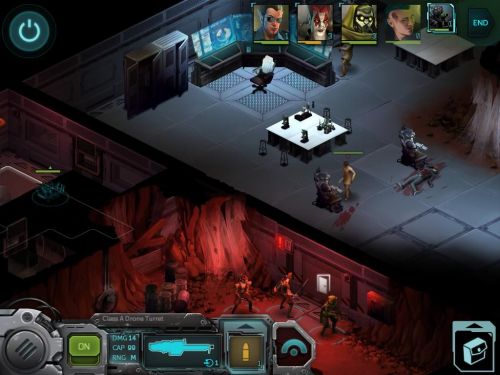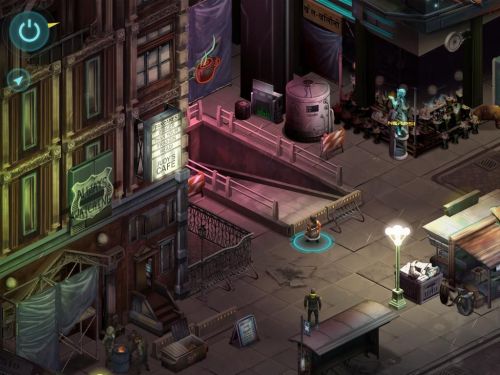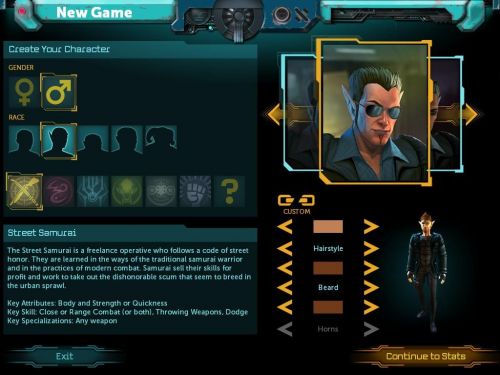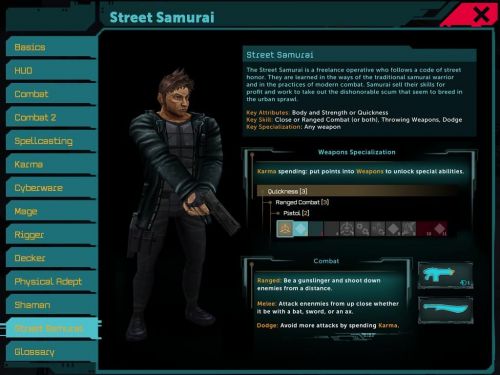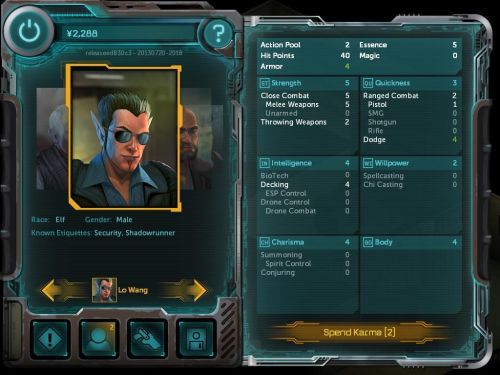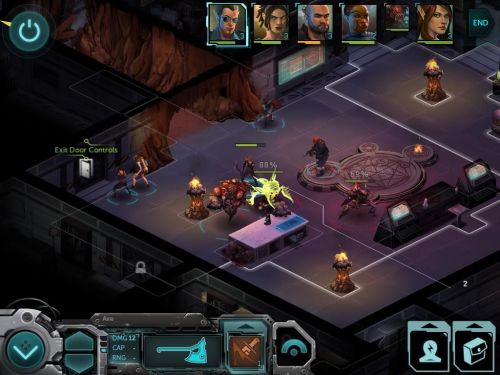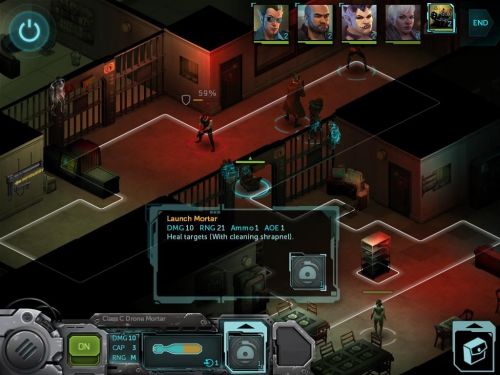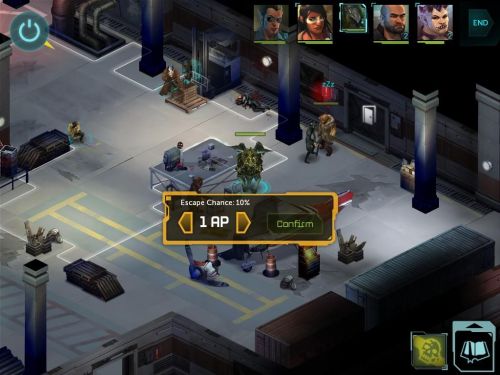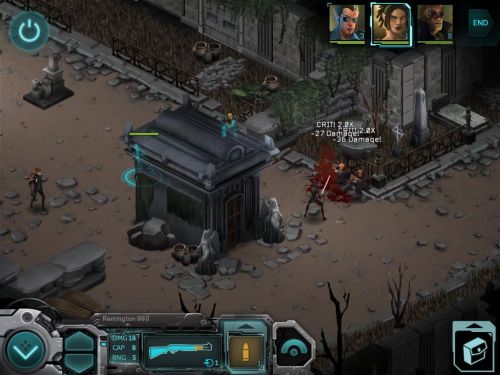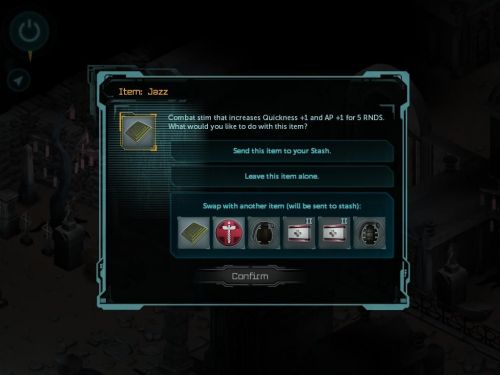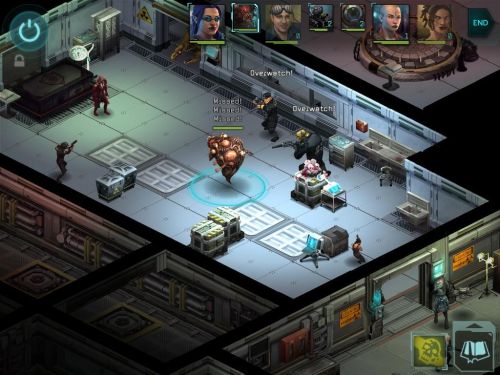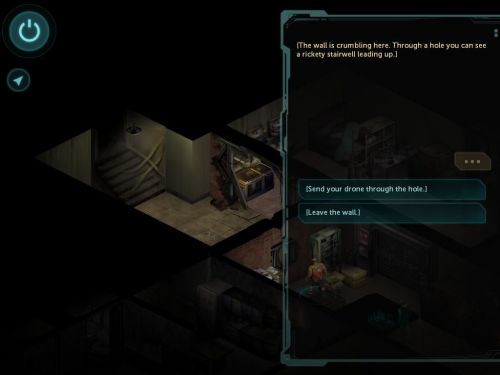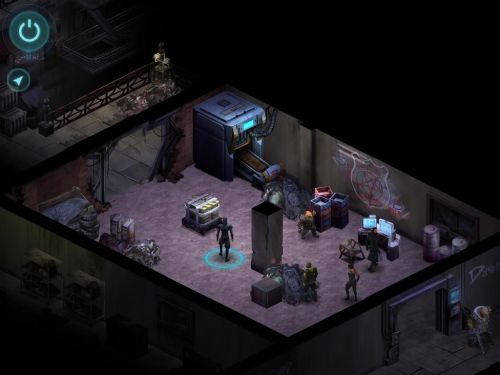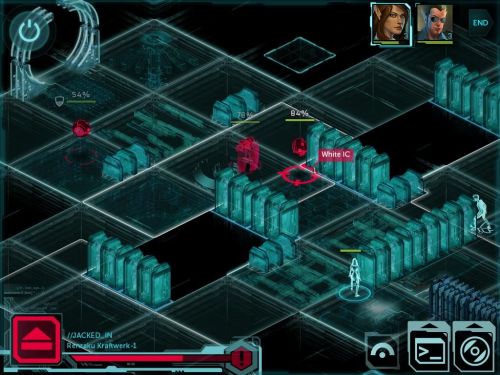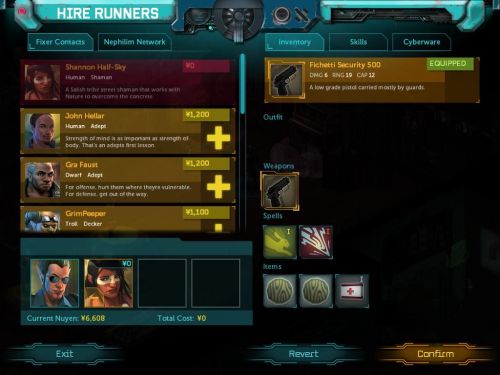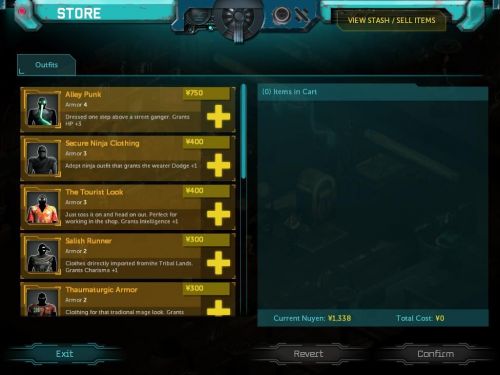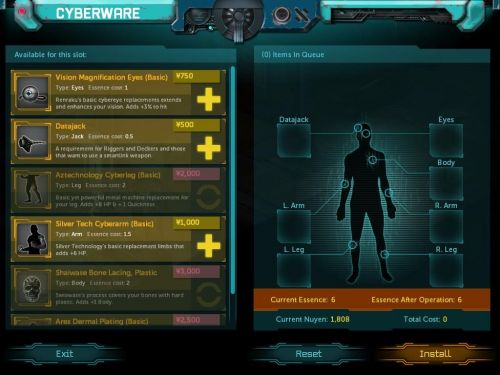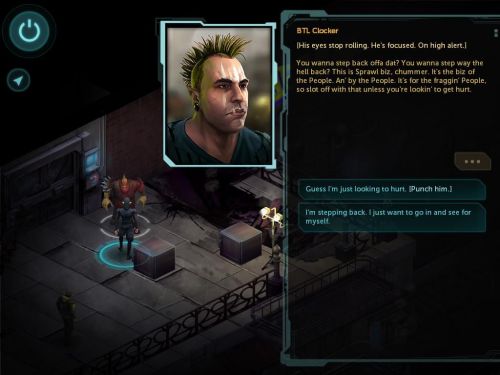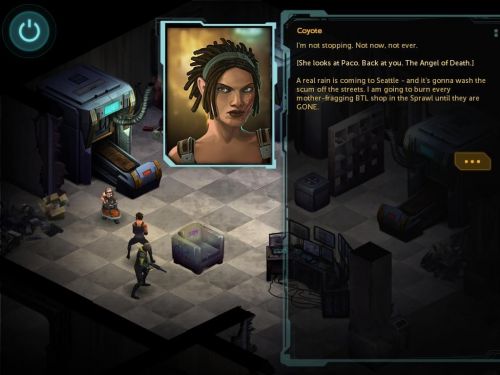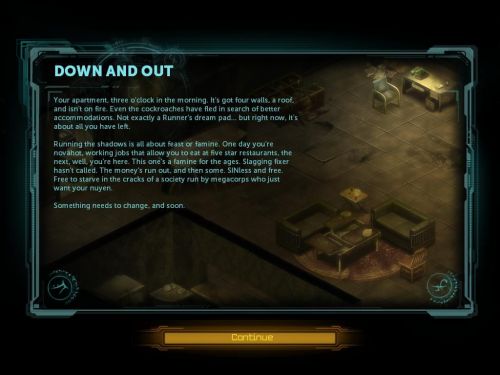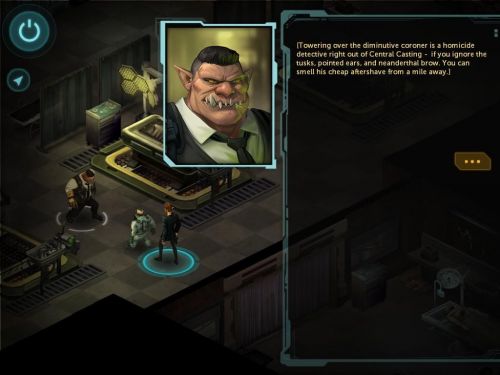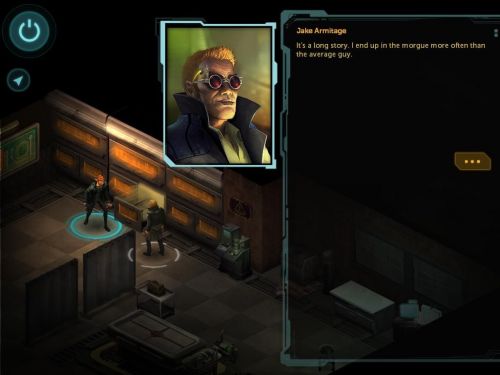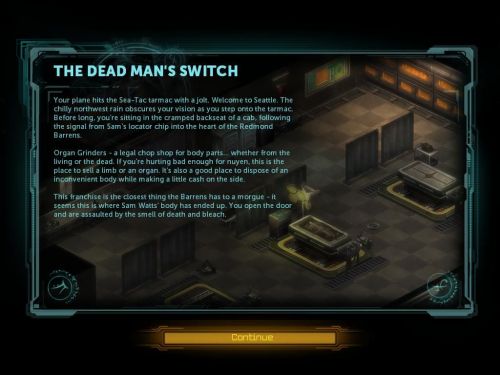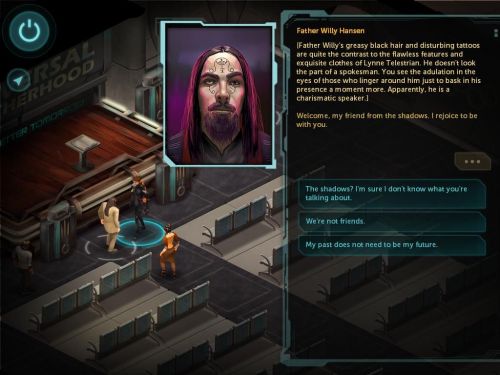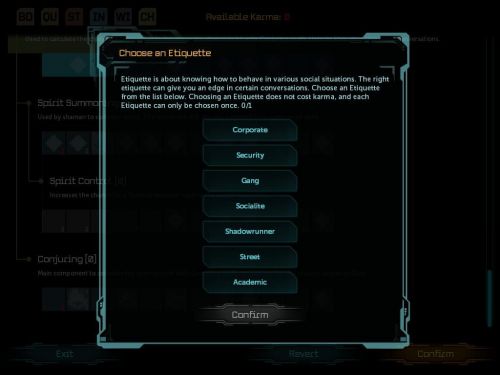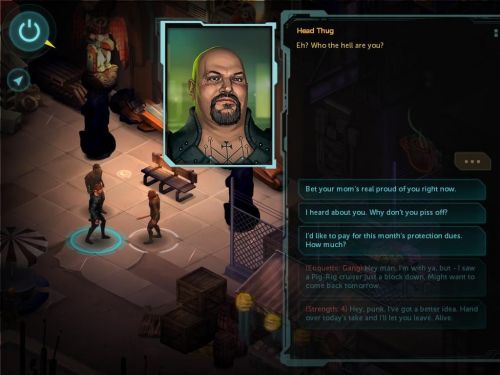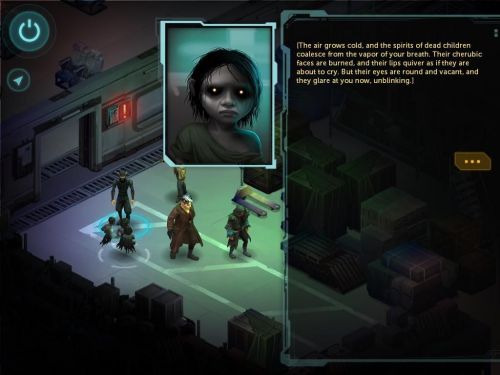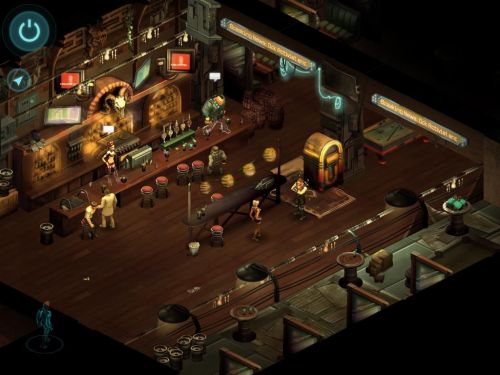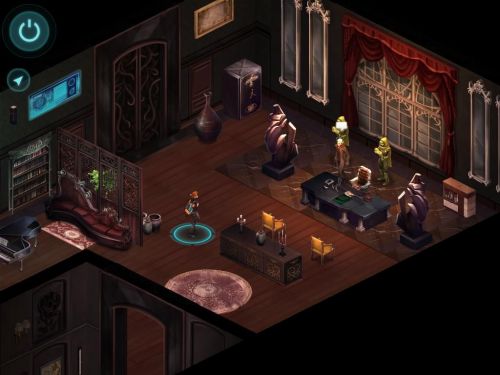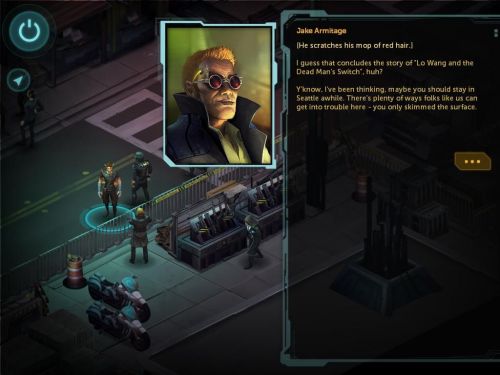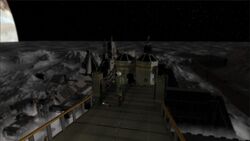RPG Codex Review: Shadowrun Returns
RPG Codex Review: Shadowrun Returns
Review - posted by Grunker on Tue 30 July 2013, 13:13:32
Tags: Harebrained Schemes; Shadowrun ReturnsWritten by Darth Roxor
Edited by Infinitron and Grunker
Hi2U, wanna cyb3r?
Shadowrun Returns, by Harebrained Schemes, probably doesn't need much introduction. It’s one of the first (if not the first?) “big” games funded by Kickstarter to have been released so far. The pitch promised a throwback to the “classic Shadowrun experience”, with turn-based combat and an atmospheric, ruthless cyberpunk world. But were these promises fulfilled?
Perhaps I should drop a disclaimer here that I've had gameplay experience with neither the pen&paper version of Shadowrun, nor with the oldies that came out for the SNES and the Sega Genesis, prior to playing this game.
A/S/L?
The world of Shadowrun Returns is a pretty interesting brew. The year is sometime in the 2050s - for all intents and purposes it is a cyberpunk setting, run by corrupt governments and mega-corporations that pull all the strings. Just with one silly detail - 40 years earlier, magic returned to the world. Elven and dwarven children were born, people mutated (“goblinised”) into trolls and orcs. Dragons, undead, extraplanar creatures and all other assorted fantasy things started popping up.
An elven hacker and an orc shaman infiltrating the offices of a megacorp full of shotgun-toting troll security officers is thus a pretty “typical” image of the world. The hacker and shaman are likely to be shadowrunners, elite commando-infiltrators who are mercenaries outside the influence of third parties, but offering their services to anyone who can offer the most coin. And it is a shadowrunner that you will get to play in this game. Right after you create him.
The character generation is pretty basic. You get to name your dude, choose a gender which doesn't really influence anything, pick a race and a portrait, choose a character archetype or invent your own, and finally spend leftover skill points, or Karma as they are called in this game.
There are five races to choose from, each with a different set of features.
Humans, like in just about every other rpg system out there, are your average blokes. All their stats are capped at average values of 9, they don’t have any weaknesses, but also no clear racial advantages, other than starting with an additional +3 karma points to spend (the in-game text says +1, but it's a mistake).
Elves, also in typical fashion, are the fancy sissies of the world. They start with +1 charisma, all their stats are capped at average values, except for Quickness and Charisma, which can be raised to 11 and 12 respectively. They make great shamans, ranged specialists and just about everything else, too.
Dwarves are probably the most stat-privileged race available, starting with +1 willpower, capping all stats at 9, except for body, willpower and strength, which are at 11, 11 and 12. Dwarves are best used as mages and adepts.
Then there are orcs. They start with +1 body and have below average charisma and intelligence, capped at 8. They can raise strength to 12 and body to 14, which also makes them good melee specialists.
And finally you have nasty trolls. As expected, they are unstoppable melee wagons of meat, starting with +1 body and strength, and capping these attributes at a whopping 17 and 15. They pay for it, however, by having really bad intelligence and charisma, capped at 6, and average quickness and willpower, capped at 8 and 9 respectively.
A couple of balance problems arise from these races. First, unless you are planning to play some sort of multiclass hybrid that probably won’t max anything, but can use every skill point available, there is absolutely no reason to play human. All the other races are better as strict specialists in various fields, and the effectively +2 karma you get at the start (since everyone else gets at least +1 from race stats) is not much of a compensation. Likewise, I find it hard to justify playing an orc, since their stats generally gear them for melee combat, but the troll is so much better for that.
Next are character archetypes. Shadowrun Returns uses a classless system, and you can off-specialise in any field you wish and create funky hybrid characters, but there are six general archetypes to mix.
There are two classes that are pretty much full-on offensive. Street samurai are the typical warriors – they use all sorts of combat skills and toughness boost to smash their enemies. Physical adepts are high risk/high reward monk-like fellows who use self-buffing spells to kamikaze rush into melee and administer horrible whoopass. They also have a very high mortality rate.
Then we have casters, the mage and the shaman. The mage is pretty self-explanatory – he can either buff allies with support magic, like heals or aiming aids, or blow everything to hell with massive balls of destruction. The shaman, on the other hand, has a handful of generally supportive spells, but he can also summon spirits in combat, either from one-use fetishes he carries, or from the environment.
The last two classes are the tech specialists, the decker and the rigger. The decker is a typical hacker, who uses software to jack into databases, download secret data and combat intrusion countermeasure programs (ICPs) in the Matrix, the game’s cyberspace. The rigger, on the other hand, can equip up to two remote-controlled drones that either carry gun turrets or a bunch of utility items like medkits and grenades.
Choosing any of these at character creation automatically assigns your starting skill points into those pre-set archetypes. You are, however, free to come up with anything of your liking and spread the points around as you prefer. And here we come to the game’s first big stinker.
The character system is one giant, unbalanced and underwhelming clusterfuck. You have six main attributes with skills assigned to them. Increasing anything to a certain level costs just as much Karma, that is, upping Charisma to 3 costs 3, then 4 to 4, etc. The skills generally act like trees, whose limits are set by superordinate stats. So, for instance, Quickness governs Ranged Combat, which in turn governs Rifles. 6 Quickness means you can advance Ranged Combat up to 6 before you need to get more Quickness. And 4 Ranged Combat sets a limit of 4 points to Rifles. As you advance through the skills, you usually unlock some new talents and moves.
All this looks alright enough, but in practice, there are so many flaws, it's simply astounding. One is the absolute lack of balance across classes. A mage, for example, effectively only needs to pump two stats – Willpower and Casting, its subordinate. Meanwhile, an adept will need to raise Willpower and Chi Casting to get his class-specific spells, then raise Strength and Close Combat and whatever weapon skill to be any effective in melee, then also get some points in Body to get additional hit points in order to not get one-hit-killed, and finally some points in Quickness and Dodge would be good to avoid enemy fire while going on a kamikaze rush.
Furthermore, most of the skill trees are boring as hell. While with a rigger you’ll be unlocking new stuff with every point you put into Drone Combat, there is nothing tangible to unlock when progressing through most of the other skills. And this is made EVEN worse considering that none of the skills even show you any numbers behind their progressions. Take Quickness, for example. For an average dude you can raise it 9 times. And its description is just this: “Used to calculate the chance to hit in ranged combat. Reduces the chance to be hit by enemy physical attacks”. It would be really dandy if I could know HOW it calculates all that and how the chances change with each level. One of Quickness's subordinates, Dodge, is particularly bad. Its description is this: “Dodge helps to reduce the chance to be hit by physical attacks”. Which is better and why? Discuss! And literally all the skills in the game are like that, except for Body which just says “every point increases HP by 10”. And finally, you have the Biotech skill, assigned to Intelligence, which has to be the most useless thing in the whole system – it adds a bonus to hp healed by medkits. Wow!
This total lack of any balancing obviously leads to some classes being a tad more useful than others. Which is even further enforced by the game structure itself. For example, mages, because of how fast they can get access to maximum in all the skills they need, are so blatantly overpowered that it's not even funny. Meanwhile, the decker, for instance, has to be the worst one there is - if you plan to make a decker as a main character, abandon that plan ASAP. It's much better to off-spec another archetype into some basic decking because a primary focus in this results in your character being almost completely useless. There are very, very few instances of actual cyberspace action, and in realspace combat the decker is granted only one meh skill that increases allied chances to hit against one target.
But at least there are many character portraits to choose from, and they all look really cool!
Never trust a dead man
Now that you have your aspiring shadowrunner created, you can go out and shoot some folks. We shall discuss Shadowrun's combat mechanics now because it is a fairly prominent part of the game.
The combat is pretty much like the rest of the game – enjoyable overall, but with a lot of room for improvements, and opaque as hell. As you probably already know, it is all turn-based, with no initiative, so all the sides in a shootout act after another one is done, and characters have a pool of 2-3 action points to use each turn, various actions having varying AP cost. It uses a cover system reminiscent of XCOM: Enemy Unknown, but with some differences. Just like in neuxcom, your characters can hide behind just about every prop on the stage, each thing having a varying degree of ‘cover’ (going from no cover, through empty shield, half shield and full shield) that reduces enemy chance to hit (but don’t ask me what exactly are the defensive values of each degree because they are not written down anywhere). What makes this different from neuxcom, however, is that the covers stack along a line of fire, i.e. hiding behind three rows of desks will be more effective than just behind one. Flanking is much less stupid and totally cover-ignoring, and I believe there are generally more angles protected by cover than actually meets the eye.
Chance to hit and damage done are calculated by completely hidden formulas derived from various skills, cover and weaponry, and the only numbers shown are total chance to hit, crit chance and average expected damage. There are also three degrees of critical hits - x1.5 damage, x2 damage, and critical failures of sorts that do only half damage. All this can also be influenced by special abilities that you unlock with karma, like a mean-ass shotgun kneecap shot that does less damage, but removes an action point from the target.
What I thought was the combat system's best aspect, was the wide array of tools it gives you. Every character archetype feels genuinely different and fun to play, throwing something unique to the mix (except for deckers, those guys suck). Pure combat dudes have 4 types of firearms – pistols, shotguns, SMGs and rifles - as well as melee weapons and different grenades. An adept will run through the entire combat zone with 1 AP then proceed to administer a triple critstike into an enemy’s face. Riggers have two types of drones that can be turned on in combat, each one sapping 1 AP to control every turn. The drones can also move into vents and flank enemies or do hit-and-run attacks. A mage has a very wide array of combat spells with different effects that use varying amounts of AP to cast, and each having a specific cooldown before it can be used for free again – using a spell off-cooldown has crazy-high HP costs that justify doing that only in very dramatic situations. The mage can also spot ley lines around the combat zones, which are fields of power that enhance his abilities. The ley lines come in three sizes, and what exactly they do I have no idea, but the biggest ones lower spell cooldowns, while the rest increase a spell’s chance to hit, I guess? A shaman has access to utility spells, as well as spirit summoning. Spirits can be called in from one-use fetish items or environmental summoning points, and much like the rigger’s drones, they sap an action point each turn to maintain their control. What makes them differ, however, is that each turn you can assign them a pool of 0-4 action points, and depending on the amount, they have a higher chance of breaking free, and each turn that chance increases. If you lose control over a spirit, it can either disappear outright or go berserk and attack everything in sight.
Not everything is fine and dandy, however. The only classes that I find hard to criticize are the rigger and the shaman, because they have the clearest sense of progression in the game, and offer some genuinely fun and sometimes risky mechanics. When a shaman’s level 6 fire spirit breaks free on the first turn of combat, you are in for a very bad time, especially if its first action is a 50-damage crit in your main character’s face. If the rigger loses his drones in the crossfire, his combat abilities are seriously hampered. But let us look at the other combat options, starting with firearms.
Pistols are alright - they have medium range, decent damage, useful talents, and are extremely cheap. But basically the only advantage they have over assault rifles, that can fire bursts, have longer range, higher damage and almost the same special combat moves, is that they are much cheaper, and can reload for free. But considering the rifles' big magazines, you hardly ever need to even reload them anyway. SMGs are somewhere between rifles and pistols, and are boring as hell. With only two special moves, you pretty much do nothing but fire medium range bursts. And finally there are shotguns, which if not for their short range, would be THE weapon to roll with. All their special shots are crazy useful, some can even fire on burst mode, they have a chance to hit multiple dudes, and they do incredible amounts of damage.
Moving on, you have melee weapons, which are horribly underdeveloped. There’s a whole total of 5 of them in the game, with a damage progression starting 2 and ending 6, and with combat moves that are rather useless unless you are an adept. But at least they damage AP on criticals, so that's neat.
And finally, you have the friggin' mages. Apart from cooldowns, there is no limitation on casting spells. If you are crafty enough, you can turn your mage into an absolute artillery engine of doom. All you need to do is load him up with 3 nukes and the Heal spell and you are set for life. Shuffling the nukes will give you some horrible fiery holocaust to use every turn, and skillfully abusing Heal will ensure you’ll never need to use a medkit – Heal removes all damage received from the most recent attack on a character. So in other words, got critted for 40 damage? No problem, just Heal! Otherwise, you’d need to spend 2 advanced medkits to patch that up.
That said, all of the above options are a bit wasted due to the game's rather low difficulty. You can sort of divide the game into two halves, and I believe it is quite telling that the only instance where I’d say it's easy to die in the first half is when your character has to go 1v1 against a mutated dog. And that’s also only if you are a shaman out of fetishes, for instance. The second half of the game has much better, sometimes even intense setpieces, where the enemy will try to overwhelm you with superior numbers, or will prepare for your coming with overwatch and heavy hardware, but it's still not enough to add a proper challenge to this game, even though these encounters are very fun to romp through. This is due to a couple of key factors.
First is the absolutely non-existent resource management. Grenades and medkits are almost completely invalidated by the existence of mages. And even without a mage, grenades are not really a necessity, since you usually pack superior firepower. And this firepower you can use entirely at your leisure, because Shadowrun Returns uses infinite ammo for all runners. You only have to reload when you run low. Honestly, I wouldn't even mind infinite ammo that much, if, say, it was inferior and you’d have limited clips of special ammunition with different effects. But there's nothing like that. The only resources you need to use sparingly are the shaman's fetishes (though even they are not as important considering the abundance of environmental spawning points) and the rigger's drone repair kits, because drones can't be Healed. There’s also no real inventory management to speak of – before each mission you can take up to 6 items per character, and that's it. There is also no looting present, but considering the items you can get, what exactly would you want to loot? More grenades?
The second, much worse problem, is the enemy AI. Sometimes, their use of cover is questionable to say the least. They don't focus fire hurt/important party members. They can't really handle mages well. They also have a very unhealthy habit of bunching up, becoming ripe pickings for all sorts of shotgunners and mages. They hardly ever, if ever, use multiple shots per turn. And even worse is the fact that their general stats are rather lackluster compared to the dudes you have under your control. Out of curiosity I inspected enemy charsheets in the editor. Turned out that the vast majority of them have only 2 AP at their disposal, while you will have 3 around the middle point of the game, and their combat skills are also average at best. What I liked, though, was that they actually have a basic morale system, and some enemies will flee in terror and sob in despair, doing nothing for a turn or two if damaged too much or if their squad suffers losses.
Finally, a weird thing about the difficulty is the difficulty setting. There are four modes – easy, normal, hard and very hard. I played on the three highest ones, and to be perfectly honest, I have no idea what differences they have. The numbers of enemies you face stay the same, and their hp largely doesn't change either, I think. I believe they only get some very basic AI tweaks, as I don’t think I've ever been bombarded by grenades on normal, while they are used more often on higher difficulties. Generally the enemies were harder to hit on hard/very hard, so I suspect they also get some minor stat boosts.
Running the Shadows
Shadowrun Returns is primarily a mission-based game, without a seamless, open world or robust exploration. Which is a darn shame because the world is rather interesting. In fact, most of the time you’ll be completely on-rails, with almost no non-linearity to speak of. There is a grand total of two full-fledged optional missions in the game, and a small handful of optional fedex quests that take some five minutes to resolve. Let's say a few words about these missions, then!
Generally, the missions are kept pretty varied thematically, and thanks to this the game always manages to stay fresh. You will be raiding corporate offices, going undercover into cultist headquarters, kidnapping scientists, and other varied stuff. The amount of things to do during the run varies greatly from mission to mission, but generally, you’ll be doing more shooty-shooty than talky-talky. Also, unfortunately, what you usually notice first is the bare minimum of exploration available. Some of the maps are actually rather spacious, but there’s hardly anything to do on them, and the empty rooms with nothing but pretty art deco just scream “cut corners!”. They don’t even have any flavour descriptions or interactions in them. Every now and again, if you wander off, you’ll find a medkit stashed somewhere, but that’s just about it.
However, sometimes different ways to get through a place pop up, and while pretty basic, they add some diversity between playthroughs. For example, during an early rescue mission where you need to get to the top floor of a bad guy's lair of evil, there are five ways in total to reach it, each using different assets of your character's stats. Neat, but sadly rare. There are also some rare, semi-flavor environmental interactions that depend on your character's race or skills – for instance, at one point when you need to get past a guard, a dwarf has the unique option to crawl through a narrow space to the other side of the guarded fence. Again, neat, but all it does is save you 20 nuyen (the game’s currency) and some 2 minutes of running around and talking to obvious people. Generally, when it comes to replay value, your overall experience of the game will hardly change, but I can guarantee that you’ll notice something new on each playthrough, even if it's the slightest thing.The replayability stems more from different character builds than it does from actual non-linearity and multiple approaches.
Some of the best moments the game has to offer are the scenes featuring the Matrix, the game's cyberspace, which is the only reason for the decker class's existence.
When jacked into the Matrix, the decker is not usable in the real world, but instead starts controlling a “persona” in a TRON-like map. Here, he can use spell and summon-like programs to combat intrusion countermeasure programs (ICPs) and enemy deckers, access secret databases and dig up dirt that you can sell to the right people, subvert enemy defences, all that cool cyberstuff. Each turn in the Matrix increases a “system alarm” bar that spawns very uncool reinforcements if it reaches maximum. There are a few types of ICPs, most of them pretty basic, like melee attacker, buffer, etc. They do damage only to the decker's persona, and cannot kill him outright, only forcibly kick him out of cyberspace. Except for the black ICPs. These, if you ask me, are the nastiest bastards you can meet in the whole friggin' game, and if you get close to two of them at once, you are toast. That's because black ICPs do direct damage to the decker, effectively frying his brain. And they do a lot of damage.
There are a few really cool scenes in the game where the decker jacks into the Matrix to search for vital info or unlock an escape route, while the rest of the party has to cover him in the real world. The game then keeps switching between 3 turns of Matrix action, and then one in the real world. Unfortunately, decking is very rare and can’t be used in every mission, despite some moments that beg for it. It's used to its fullest only in three missions, I’d say, while the other (also three) instances are rather meaningless and too short.
Aiding you in these runs will be up to three party members that you’ll usually be able to hire before embarking on a mission. They all come with their own stats and gear that progress with the game, and pretty much at all stages of the game they are inferior to your character. The mercs are generally walking statsheets with no interaction, but I personally don’t find that to be much of a flaw. There are quite a few of them to choose from, and they come in two types. One are the regular shadowrunners, focused specialists that you can hire through a certain Mr Delilah. The other group are the Nephilim Network – all of them except for two gunmasters are hybrids that incorporate traits across multiple classes. Some of those can be pretty useful, like a support mage that has both shaman and mage spells, and some are downright hilariously useless, like a physical adept with no close combat skills, focusing on pistols instead. The normal shadowrunners cost around 2400 each, while the Nephilim dudes are either 1k or 3k. And interestingly enough, some of those 1k blokes, like the “combat decker”, are actually far superior to their shadowrunner counterparts.
What I liked about the hirelings was that they cover many different areas of character building, and none of them, except for one mage who is crazy good, are the clear “optimal” choices when compared to the rest. Another thing I thought was cool, was that the shadowrunner mercs have randomised names and portraits on each play - a minor thing, but it's neat. What wasn't so cool, however, was that they are all essentially immortal – if a merc dies during a run, he’ll be available again in the roster for the next mission. And finally, adept mercs? Don’t take them. They are built so horribly that they are almost completely useless. I took adept mercs only twice on two different missions, and lo and behold, both times they actually managed to hit the dirt.
Speaking of hiring, let’s talk money. Depending on what you play, money will vary on each playthrough. There are some folks that use a lot of it, like riggers, shamans or rifle users in general, and others that almost never spend anything, like melee street samurai. At least the cool thing is that you always have something to spend it on, even if those are super-luxury cybernetic augmentations that are so ridiculously overpriced for what they do it’s not even funny. They cost thousands of nuyen, but usually their effect is something like “+1 [stat]”. They are also a no-go for casters because each augment reduces your character’s “essence”, and thus increases spell cooldowns. But casters have plenty other stuff to spend money on, like new spells, new fetishes or new suits of clothing (that follow the dishonorable tradition of “adds stats for no reason”, like a “tourist look” hawaii shirt and shorts that give +1 intelligence). Income usually comes from three sources – reselling obsolete equipment, getting cash-bombs “to hire runners”, and pawning secret data and valuables to a fence.
Null sheen, chummer
If there is one thing that Shadowrun Returns does absolutely splendidly, though, it's giving you the feeling that you are actually in the Shadowrun world. Everything is properly gritty and punky, you've got hookers, gangers and junkies around every corner. You've got troll bouncers, elf businessmen and corporate mages with hooded coats, white shirts and neckties. Everyone uses the setting's specific slang, which reminded me a lot of all the berks and cutters you used to hear in Planescape Torment.
The writing, too, is generally solid, even great at times, and reaches stupidity only very rarely. You have tons upon tons of description in dialogues, the dialogues are long and expressive, everything feels right. The game simply oozes cyberpunk atmosphere and charm, you keep reading a lot of backstory, different people's different runs in different places, and it only leaves you with a hunger for more, and a sadness that you can’t participate in these events or at least investigate them further.
The story itself is pretty interesting as well, although at one point it feels like two separate ones, and some people claim it's actually probably more enjoyable to people who are not familiar with Shadowrun lore.
You can view the whole game as one big interplay of contrasts, where one thing is awesome and the other sucks, where some parts are good but would be great with improvements, and the narrative part of the game isn't any different. The funny thing is that while the first part of the game is much inferior to the second combat-wise, the opposite is true for the story. It starts as a low-key noir detective story, where you are contacted by a post-mortem message of your old buddy, Sam Watts, who’s had a “dead man’s switch” installed – a system that’s supposed to activate the moment the user is killed, and contact whatever appointed recipient. Sam kicked the bucket and wants his killer brought to justice. And he offers good coin in return. Afterwards, the story, let’s say, goes places, and becomes much more high-end later on, including a handful of apparently awkward ‘epic’ namedrops from the Shadowrun universe.
Going back to the dialogues, unfortunately, while they are very well written, there is not really much depth to them. That is to say, most of them are very Biowarian™, in that most of the dialogue choices lead to the same responses, or just flavor different ones. There are, however, a few instances where you need to watch your mouth or you’ll blow your cover, or one fedex quest that you can deny yourself if you are an asshole to the quest giver. There are also a few stinkers here and there, one that is so mind-boggling stupid, I can’t imagine how the devs didn't realize that it’s just dumb. Although I have my theory that it was a last-minute hackjob to repurpose the level, based on leftover cut content I found in the editor. Basically, picture this: there is this corporate security chief who is repeatedly described as “extra-paranoid”, even to the point that he installs security systems completely at random. And what does he goddamn do? Invite a shady-looking janitor that conveniently enough has found a bunch of important problems a few floors down right into his office, where he keeps SUPER-SECRET STUFF, then leaves the janitor there completely alone to “write a report”, and goes down to investigate. What the shit.
Sometimes skill-checks pop-up in dialogues, and these are another problem. Your only “social” skills are your etiquettes – you get one by default at the start, and then you can choose one more for every two charisma points. Most of these etiquettes hardly do anything – they are either just another flavour choice, or they can save you some meager amounts of cash or time, generally nothing gamechanging. They only come into play frequently when you try to sell stuff to a fence – everything always has an etiquette check to negotiate more money, sometimes even pretty high sums. But some of the etiquettes are clearly superior to the others, and while there are two that pop up almost all the time, one of them, Socialite, literally sees only one use. Only a single friggin' one.
One more skill that’s often used in dialogue screens is decking, which you can often pick to dig up dirty secrets for sale or unlock new pathways. Unfortunately, there's also barely any reactivity in the dialogues, which is a bit of a shame. Race is referenced often, but it's just a flavor [input race here] in normal dialogues with no real differences, while references to equipment or class never pop up. What I liked, though, was that at least in some cases, some stat-checks were hidden, and not just grayed out but visible.
As a final remark in this chapter, let’s talk about choices, because I think this is an outright cock-up on the game's part. The only choices you will ever make that have any impact are basically “do I return the fedex item to the quest giver for +karma or sell it to the fence?” (and even then, you can’t just take the item and scram, no, to unlock the fence's selling dialogue, you have to first go to the quest-giver and wave your balls in his face). There’s also another one where you can bribe a cop, and he’ll conveniently leave you a computer with secret info to plunder during another mission. And that’s just about it. This is particularly infuriating in the context of some events in the game that simply scream “this will have repercussions!”.
The worst offender is probably the investigation of a crime scene in the docks. The local shaman tells you that you can summon some spirits that witnessed the scene, but you’ll need at least two ‘haunted items’ of theirs to do the summoning. There are actually four such items on the map, and getting some of them has hidden skillchecks. So I felt pretty damn clever and special when I got all 4 on one playthrough, while I had found only 2 on the previous one. And what is the reward you get for being inquisitive? Absolutely friggin’ nothing. You summon the spirits, keep showing them the items, get info... and when you get to the fourth one, they basically just say “screw you, can I go now?”. And if you say “no, I have more questions”, they leave with this ominous “We’ll have need of you later!” message. But nothing. Ever. Happens.
Skuzzy Warez
Finally, let's talk about the technical aspect of the game, because there is a lot to mention.
Let’s start with the good parts. The graphics and the music. Shadowrun's isometric 2D graphics are simply gorgeous and a feast for the eyes. Whether you are going through nighttime downtown Seattle or through corporate offices, there is so much detail and great art direction to behold, you’ll be stopping to admire the view at times.
And the music, by God almighty, I swear this is the game’s best part. It’s simply perfect. If I had to describe it, I would say it's a mix of the kick-ass electro-rock of Crusader: No Regret, the ominous techno of System Shock 2 and the 8-bit beep-boops of Blake Stone. Seriously, all the tracks are memorable, great and go very well with the action happening on screen. Some of them are also pretty good remixes of classic SNES tracks, like Seattle Blues. I am not exaggerating when I say that this game is worth buying and playing if only to experience the soundtrack.
Moving on to the interface, it's fairly slick and easy to use, nothing to really write home about. It feels a bit like a big PDA, which I guess is to be expected considering that SRR was developed for PC and iPhones. Keyboard hotkeys are there, and while most of the functions are fairly obvious, you have to find out what most of the stuff does yourself because neither is the help screen particularly helpful, nor are you supplied with any manual in the folder (at least I wasn't). The bad stuff concerning functionality is that sometimes it’s a bit cumbersome to click on environmental icons, and the game tends to stutter briefly when you are switching through menus.
One thing you might find annoying is the save system. There is no manual saving, only checkpoints at the start of a level. And depending on the mission, these can even be half an hour apart, though I generally didn't find it too bad because I found I could just steamroll through levels and never really had to reload. Which makes me wonder if that’s not one of the reasons why the difficulty is so low to begin with, as frequent repetition of entire levels could be frustrating.
One of the game’s supposed selling points was the editor, but to be frank, I didn't investigate it much. My experience with modding is very much null, so I figured my impressions wouldn't be very helpful. I only used it to inspect the campaign module to check for stuff I might have missed, and in turn I found some more funny things, such as apparently leftover cut content. A damn shame, too, because there were at least two cut missions and both of them sounded very interesting from the bits and pieces that I saw (one clearly a side mission, as well). The game generally shows many cut corners. I guess Harebrained were running out of funds fast and had to focus on putting out a finished and “focused” product on time, even if it meant some flaws would creep in. I can say that they succeeded, but when you think just how much better this game would be if it had a bigger budget, you feel kinda sad. Like, say, if a few million dollars were transferred to them from the account of That Inept Developer That Shall Not Be Named that essentially defrauded a whole bunch of backers recently.
And finally, we move on to the ugly parts. The bugs. I've played through the game three times, and while on the first playthrough with a melee dude I didn't find any worth mentioning, in the subsequent playthroughs with a shaman and a rigger the bugs reared their heads a bit.
The least offensive bugs are the typos in writing. They don’t pop up in dialogues all that much, but there are a lot of them in various parts of the interface.
But there are also those that creep into gameplay, and they are very often quite nasty. For instance, there are skills that just outright stop working, like the Pommel Strike melee move. It’s a no-damage hit that’s supposed to sap enemy AP. Around the middle of the game, the skill stopped doing anything. No damage, no AP damage, nothing. You also get instances of spell slots disappearing mysteriously and drones that lose max AP for no reason. Line of sight in combat can get wonky, with the shooter being able to shoot, but the victim not able to retaliate. I've seen people report vital quest scripts not kicking in, too, but fortunately I've been spared those. There’s also one “feature” that is particularly annoying for adepts – to be of any use, adepts need to spend a lot of time using self-buff spells. If a conversation happens during combat, they lose all the buffs, but their spell cooldowns don’t reset. And those are only a few of the game's bugs that I remember right now or know about.
Apart from the bugs, though, the game was very stable. I didn't get any random crashes, it didn't format my hard drive, nor burn through any vital components.
You have been judged
I find it hard to provide a verdict for Shadowrun Returns. On one hand, it has clear flaws, some that are even glaring. It’s short as hell, and a playthrough will take you something around 13 hours tops. Its replay value is a bit questionable. It’s more of a fast-food kind of deal than an actual full-scale game.
On the other hand, you have to be fair and keep in mind the game's limited budget in the context of its flaws. Not to mention that the peanuts this game costs offer you a tremendous ratio of bang for your buck. There's also the prospect of fan-made scenarios coming out from the editor. And, finally, what I guess has the most (albeit subjective) say on the matter, is that I simply fragging enjoyed my time with the game. I'm keeping my fingers crossed tightly for the upcoming official campaign in Berlin that's supposed to have a more open world and more side missions.
Edited by Infinitron and Grunker
Hi2U, wanna cyb3r?
Shadowrun Returns, by Harebrained Schemes, probably doesn't need much introduction. It’s one of the first (if not the first?) “big” games funded by Kickstarter to have been released so far. The pitch promised a throwback to the “classic Shadowrun experience”, with turn-based combat and an atmospheric, ruthless cyberpunk world. But were these promises fulfilled?
Perhaps I should drop a disclaimer here that I've had gameplay experience with neither the pen&paper version of Shadowrun, nor with the oldies that came out for the SNES and the Sega Genesis, prior to playing this game.
A/S/L?
The world of Shadowrun Returns is a pretty interesting brew. The year is sometime in the 2050s - for all intents and purposes it is a cyberpunk setting, run by corrupt governments and mega-corporations that pull all the strings. Just with one silly detail - 40 years earlier, magic returned to the world. Elven and dwarven children were born, people mutated (“goblinised”) into trolls and orcs. Dragons, undead, extraplanar creatures and all other assorted fantasy things started popping up.
An elven hacker and an orc shaman infiltrating the offices of a megacorp full of shotgun-toting troll security officers is thus a pretty “typical” image of the world. The hacker and shaman are likely to be shadowrunners, elite commando-infiltrators who are mercenaries outside the influence of third parties, but offering their services to anyone who can offer the most coin. And it is a shadowrunner that you will get to play in this game. Right after you create him.
The character generation is pretty basic. You get to name your dude, choose a gender which doesn't really influence anything, pick a race and a portrait, choose a character archetype or invent your own, and finally spend leftover skill points, or Karma as they are called in this game.
There are five races to choose from, each with a different set of features.
Humans, like in just about every other rpg system out there, are your average blokes. All their stats are capped at average values of 9, they don’t have any weaknesses, but also no clear racial advantages, other than starting with an additional +3 karma points to spend (the in-game text says +1, but it's a mistake).
Elves, also in typical fashion, are the fancy sissies of the world. They start with +1 charisma, all their stats are capped at average values, except for Quickness and Charisma, which can be raised to 11 and 12 respectively. They make great shamans, ranged specialists and just about everything else, too.
Dwarves are probably the most stat-privileged race available, starting with +1 willpower, capping all stats at 9, except for body, willpower and strength, which are at 11, 11 and 12. Dwarves are best used as mages and adepts.
Then there are orcs. They start with +1 body and have below average charisma and intelligence, capped at 8. They can raise strength to 12 and body to 14, which also makes them good melee specialists.
And finally you have nasty trolls. As expected, they are unstoppable melee wagons of meat, starting with +1 body and strength, and capping these attributes at a whopping 17 and 15. They pay for it, however, by having really bad intelligence and charisma, capped at 6, and average quickness and willpower, capped at 8 and 9 respectively.
A couple of balance problems arise from these races. First, unless you are planning to play some sort of multiclass hybrid that probably won’t max anything, but can use every skill point available, there is absolutely no reason to play human. All the other races are better as strict specialists in various fields, and the effectively +2 karma you get at the start (since everyone else gets at least +1 from race stats) is not much of a compensation. Likewise, I find it hard to justify playing an orc, since their stats generally gear them for melee combat, but the troll is so much better for that.
Next are character archetypes. Shadowrun Returns uses a classless system, and you can off-specialise in any field you wish and create funky hybrid characters, but there are six general archetypes to mix.
There are two classes that are pretty much full-on offensive. Street samurai are the typical warriors – they use all sorts of combat skills and toughness boost to smash their enemies. Physical adepts are high risk/high reward monk-like fellows who use self-buffing spells to kamikaze rush into melee and administer horrible whoopass. They also have a very high mortality rate.
Then we have casters, the mage and the shaman. The mage is pretty self-explanatory – he can either buff allies with support magic, like heals or aiming aids, or blow everything to hell with massive balls of destruction. The shaman, on the other hand, has a handful of generally supportive spells, but he can also summon spirits in combat, either from one-use fetishes he carries, or from the environment.
The last two classes are the tech specialists, the decker and the rigger. The decker is a typical hacker, who uses software to jack into databases, download secret data and combat intrusion countermeasure programs (ICPs) in the Matrix, the game’s cyberspace. The rigger, on the other hand, can equip up to two remote-controlled drones that either carry gun turrets or a bunch of utility items like medkits and grenades.
Choosing any of these at character creation automatically assigns your starting skill points into those pre-set archetypes. You are, however, free to come up with anything of your liking and spread the points around as you prefer. And here we come to the game’s first big stinker.
The character system is one giant, unbalanced and underwhelming clusterfuck. You have six main attributes with skills assigned to them. Increasing anything to a certain level costs just as much Karma, that is, upping Charisma to 3 costs 3, then 4 to 4, etc. The skills generally act like trees, whose limits are set by superordinate stats. So, for instance, Quickness governs Ranged Combat, which in turn governs Rifles. 6 Quickness means you can advance Ranged Combat up to 6 before you need to get more Quickness. And 4 Ranged Combat sets a limit of 4 points to Rifles. As you advance through the skills, you usually unlock some new talents and moves.
All this looks alright enough, but in practice, there are so many flaws, it's simply astounding. One is the absolute lack of balance across classes. A mage, for example, effectively only needs to pump two stats – Willpower and Casting, its subordinate. Meanwhile, an adept will need to raise Willpower and Chi Casting to get his class-specific spells, then raise Strength and Close Combat and whatever weapon skill to be any effective in melee, then also get some points in Body to get additional hit points in order to not get one-hit-killed, and finally some points in Quickness and Dodge would be good to avoid enemy fire while going on a kamikaze rush.
Furthermore, most of the skill trees are boring as hell. While with a rigger you’ll be unlocking new stuff with every point you put into Drone Combat, there is nothing tangible to unlock when progressing through most of the other skills. And this is made EVEN worse considering that none of the skills even show you any numbers behind their progressions. Take Quickness, for example. For an average dude you can raise it 9 times. And its description is just this: “Used to calculate the chance to hit in ranged combat. Reduces the chance to be hit by enemy physical attacks”. It would be really dandy if I could know HOW it calculates all that and how the chances change with each level. One of Quickness's subordinates, Dodge, is particularly bad. Its description is this: “Dodge helps to reduce the chance to be hit by physical attacks”. Which is better and why? Discuss! And literally all the skills in the game are like that, except for Body which just says “every point increases HP by 10”. And finally, you have the Biotech skill, assigned to Intelligence, which has to be the most useless thing in the whole system – it adds a bonus to hp healed by medkits. Wow!
This total lack of any balancing obviously leads to some classes being a tad more useful than others. Which is even further enforced by the game structure itself. For example, mages, because of how fast they can get access to maximum in all the skills they need, are so blatantly overpowered that it's not even funny. Meanwhile, the decker, for instance, has to be the worst one there is - if you plan to make a decker as a main character, abandon that plan ASAP. It's much better to off-spec another archetype into some basic decking because a primary focus in this results in your character being almost completely useless. There are very, very few instances of actual cyberspace action, and in realspace combat the decker is granted only one meh skill that increases allied chances to hit against one target.
But at least there are many character portraits to choose from, and they all look really cool!
Never trust a dead man
Now that you have your aspiring shadowrunner created, you can go out and shoot some folks. We shall discuss Shadowrun's combat mechanics now because it is a fairly prominent part of the game.
The combat is pretty much like the rest of the game – enjoyable overall, but with a lot of room for improvements, and opaque as hell. As you probably already know, it is all turn-based, with no initiative, so all the sides in a shootout act after another one is done, and characters have a pool of 2-3 action points to use each turn, various actions having varying AP cost. It uses a cover system reminiscent of XCOM: Enemy Unknown, but with some differences. Just like in neuxcom, your characters can hide behind just about every prop on the stage, each thing having a varying degree of ‘cover’ (going from no cover, through empty shield, half shield and full shield) that reduces enemy chance to hit (but don’t ask me what exactly are the defensive values of each degree because they are not written down anywhere). What makes this different from neuxcom, however, is that the covers stack along a line of fire, i.e. hiding behind three rows of desks will be more effective than just behind one. Flanking is much less stupid and totally cover-ignoring, and I believe there are generally more angles protected by cover than actually meets the eye.
Chance to hit and damage done are calculated by completely hidden formulas derived from various skills, cover and weaponry, and the only numbers shown are total chance to hit, crit chance and average expected damage. There are also three degrees of critical hits - x1.5 damage, x2 damage, and critical failures of sorts that do only half damage. All this can also be influenced by special abilities that you unlock with karma, like a mean-ass shotgun kneecap shot that does less damage, but removes an action point from the target.
What I thought was the combat system's best aspect, was the wide array of tools it gives you. Every character archetype feels genuinely different and fun to play, throwing something unique to the mix (except for deckers, those guys suck). Pure combat dudes have 4 types of firearms – pistols, shotguns, SMGs and rifles - as well as melee weapons and different grenades. An adept will run through the entire combat zone with 1 AP then proceed to administer a triple critstike into an enemy’s face. Riggers have two types of drones that can be turned on in combat, each one sapping 1 AP to control every turn. The drones can also move into vents and flank enemies or do hit-and-run attacks. A mage has a very wide array of combat spells with different effects that use varying amounts of AP to cast, and each having a specific cooldown before it can be used for free again – using a spell off-cooldown has crazy-high HP costs that justify doing that only in very dramatic situations. The mage can also spot ley lines around the combat zones, which are fields of power that enhance his abilities. The ley lines come in three sizes, and what exactly they do I have no idea, but the biggest ones lower spell cooldowns, while the rest increase a spell’s chance to hit, I guess? A shaman has access to utility spells, as well as spirit summoning. Spirits can be called in from one-use fetish items or environmental summoning points, and much like the rigger’s drones, they sap an action point each turn to maintain their control. What makes them differ, however, is that each turn you can assign them a pool of 0-4 action points, and depending on the amount, they have a higher chance of breaking free, and each turn that chance increases. If you lose control over a spirit, it can either disappear outright or go berserk and attack everything in sight.
Not everything is fine and dandy, however. The only classes that I find hard to criticize are the rigger and the shaman, because they have the clearest sense of progression in the game, and offer some genuinely fun and sometimes risky mechanics. When a shaman’s level 6 fire spirit breaks free on the first turn of combat, you are in for a very bad time, especially if its first action is a 50-damage crit in your main character’s face. If the rigger loses his drones in the crossfire, his combat abilities are seriously hampered. But let us look at the other combat options, starting with firearms.
Pistols are alright - they have medium range, decent damage, useful talents, and are extremely cheap. But basically the only advantage they have over assault rifles, that can fire bursts, have longer range, higher damage and almost the same special combat moves, is that they are much cheaper, and can reload for free. But considering the rifles' big magazines, you hardly ever need to even reload them anyway. SMGs are somewhere between rifles and pistols, and are boring as hell. With only two special moves, you pretty much do nothing but fire medium range bursts. And finally there are shotguns, which if not for their short range, would be THE weapon to roll with. All their special shots are crazy useful, some can even fire on burst mode, they have a chance to hit multiple dudes, and they do incredible amounts of damage.
Moving on, you have melee weapons, which are horribly underdeveloped. There’s a whole total of 5 of them in the game, with a damage progression starting 2 and ending 6, and with combat moves that are rather useless unless you are an adept. But at least they damage AP on criticals, so that's neat.
And finally, you have the friggin' mages. Apart from cooldowns, there is no limitation on casting spells. If you are crafty enough, you can turn your mage into an absolute artillery engine of doom. All you need to do is load him up with 3 nukes and the Heal spell and you are set for life. Shuffling the nukes will give you some horrible fiery holocaust to use every turn, and skillfully abusing Heal will ensure you’ll never need to use a medkit – Heal removes all damage received from the most recent attack on a character. So in other words, got critted for 40 damage? No problem, just Heal! Otherwise, you’d need to spend 2 advanced medkits to patch that up.
That said, all of the above options are a bit wasted due to the game's rather low difficulty. You can sort of divide the game into two halves, and I believe it is quite telling that the only instance where I’d say it's easy to die in the first half is when your character has to go 1v1 against a mutated dog. And that’s also only if you are a shaman out of fetishes, for instance. The second half of the game has much better, sometimes even intense setpieces, where the enemy will try to overwhelm you with superior numbers, or will prepare for your coming with overwatch and heavy hardware, but it's still not enough to add a proper challenge to this game, even though these encounters are very fun to romp through. This is due to a couple of key factors.
First is the absolutely non-existent resource management. Grenades and medkits are almost completely invalidated by the existence of mages. And even without a mage, grenades are not really a necessity, since you usually pack superior firepower. And this firepower you can use entirely at your leisure, because Shadowrun Returns uses infinite ammo for all runners. You only have to reload when you run low. Honestly, I wouldn't even mind infinite ammo that much, if, say, it was inferior and you’d have limited clips of special ammunition with different effects. But there's nothing like that. The only resources you need to use sparingly are the shaman's fetishes (though even they are not as important considering the abundance of environmental spawning points) and the rigger's drone repair kits, because drones can't be Healed. There’s also no real inventory management to speak of – before each mission you can take up to 6 items per character, and that's it. There is also no looting present, but considering the items you can get, what exactly would you want to loot? More grenades?
The second, much worse problem, is the enemy AI. Sometimes, their use of cover is questionable to say the least. They don't focus fire hurt/important party members. They can't really handle mages well. They also have a very unhealthy habit of bunching up, becoming ripe pickings for all sorts of shotgunners and mages. They hardly ever, if ever, use multiple shots per turn. And even worse is the fact that their general stats are rather lackluster compared to the dudes you have under your control. Out of curiosity I inspected enemy charsheets in the editor. Turned out that the vast majority of them have only 2 AP at their disposal, while you will have 3 around the middle point of the game, and their combat skills are also average at best. What I liked, though, was that they actually have a basic morale system, and some enemies will flee in terror and sob in despair, doing nothing for a turn or two if damaged too much or if their squad suffers losses.
Finally, a weird thing about the difficulty is the difficulty setting. There are four modes – easy, normal, hard and very hard. I played on the three highest ones, and to be perfectly honest, I have no idea what differences they have. The numbers of enemies you face stay the same, and their hp largely doesn't change either, I think. I believe they only get some very basic AI tweaks, as I don’t think I've ever been bombarded by grenades on normal, while they are used more often on higher difficulties. Generally the enemies were harder to hit on hard/very hard, so I suspect they also get some minor stat boosts.
Running the Shadows
Shadowrun Returns is primarily a mission-based game, without a seamless, open world or robust exploration. Which is a darn shame because the world is rather interesting. In fact, most of the time you’ll be completely on-rails, with almost no non-linearity to speak of. There is a grand total of two full-fledged optional missions in the game, and a small handful of optional fedex quests that take some five minutes to resolve. Let's say a few words about these missions, then!
Generally, the missions are kept pretty varied thematically, and thanks to this the game always manages to stay fresh. You will be raiding corporate offices, going undercover into cultist headquarters, kidnapping scientists, and other varied stuff. The amount of things to do during the run varies greatly from mission to mission, but generally, you’ll be doing more shooty-shooty than talky-talky. Also, unfortunately, what you usually notice first is the bare minimum of exploration available. Some of the maps are actually rather spacious, but there’s hardly anything to do on them, and the empty rooms with nothing but pretty art deco just scream “cut corners!”. They don’t even have any flavour descriptions or interactions in them. Every now and again, if you wander off, you’ll find a medkit stashed somewhere, but that’s just about it.
However, sometimes different ways to get through a place pop up, and while pretty basic, they add some diversity between playthroughs. For example, during an early rescue mission where you need to get to the top floor of a bad guy's lair of evil, there are five ways in total to reach it, each using different assets of your character's stats. Neat, but sadly rare. There are also some rare, semi-flavor environmental interactions that depend on your character's race or skills – for instance, at one point when you need to get past a guard, a dwarf has the unique option to crawl through a narrow space to the other side of the guarded fence. Again, neat, but all it does is save you 20 nuyen (the game’s currency) and some 2 minutes of running around and talking to obvious people. Generally, when it comes to replay value, your overall experience of the game will hardly change, but I can guarantee that you’ll notice something new on each playthrough, even if it's the slightest thing.The replayability stems more from different character builds than it does from actual non-linearity and multiple approaches.
Some of the best moments the game has to offer are the scenes featuring the Matrix, the game's cyberspace, which is the only reason for the decker class's existence.
When jacked into the Matrix, the decker is not usable in the real world, but instead starts controlling a “persona” in a TRON-like map. Here, he can use spell and summon-like programs to combat intrusion countermeasure programs (ICPs) and enemy deckers, access secret databases and dig up dirt that you can sell to the right people, subvert enemy defences, all that cool cyberstuff. Each turn in the Matrix increases a “system alarm” bar that spawns very uncool reinforcements if it reaches maximum. There are a few types of ICPs, most of them pretty basic, like melee attacker, buffer, etc. They do damage only to the decker's persona, and cannot kill him outright, only forcibly kick him out of cyberspace. Except for the black ICPs. These, if you ask me, are the nastiest bastards you can meet in the whole friggin' game, and if you get close to two of them at once, you are toast. That's because black ICPs do direct damage to the decker, effectively frying his brain. And they do a lot of damage.
There are a few really cool scenes in the game where the decker jacks into the Matrix to search for vital info or unlock an escape route, while the rest of the party has to cover him in the real world. The game then keeps switching between 3 turns of Matrix action, and then one in the real world. Unfortunately, decking is very rare and can’t be used in every mission, despite some moments that beg for it. It's used to its fullest only in three missions, I’d say, while the other (also three) instances are rather meaningless and too short.
Aiding you in these runs will be up to three party members that you’ll usually be able to hire before embarking on a mission. They all come with their own stats and gear that progress with the game, and pretty much at all stages of the game they are inferior to your character. The mercs are generally walking statsheets with no interaction, but I personally don’t find that to be much of a flaw. There are quite a few of them to choose from, and they come in two types. One are the regular shadowrunners, focused specialists that you can hire through a certain Mr Delilah. The other group are the Nephilim Network – all of them except for two gunmasters are hybrids that incorporate traits across multiple classes. Some of those can be pretty useful, like a support mage that has both shaman and mage spells, and some are downright hilariously useless, like a physical adept with no close combat skills, focusing on pistols instead. The normal shadowrunners cost around 2400 each, while the Nephilim dudes are either 1k or 3k. And interestingly enough, some of those 1k blokes, like the “combat decker”, are actually far superior to their shadowrunner counterparts.
What I liked about the hirelings was that they cover many different areas of character building, and none of them, except for one mage who is crazy good, are the clear “optimal” choices when compared to the rest. Another thing I thought was cool, was that the shadowrunner mercs have randomised names and portraits on each play - a minor thing, but it's neat. What wasn't so cool, however, was that they are all essentially immortal – if a merc dies during a run, he’ll be available again in the roster for the next mission. And finally, adept mercs? Don’t take them. They are built so horribly that they are almost completely useless. I took adept mercs only twice on two different missions, and lo and behold, both times they actually managed to hit the dirt.
Speaking of hiring, let’s talk money. Depending on what you play, money will vary on each playthrough. There are some folks that use a lot of it, like riggers, shamans or rifle users in general, and others that almost never spend anything, like melee street samurai. At least the cool thing is that you always have something to spend it on, even if those are super-luxury cybernetic augmentations that are so ridiculously overpriced for what they do it’s not even funny. They cost thousands of nuyen, but usually their effect is something like “+1 [stat]”. They are also a no-go for casters because each augment reduces your character’s “essence”, and thus increases spell cooldowns. But casters have plenty other stuff to spend money on, like new spells, new fetishes or new suits of clothing (that follow the dishonorable tradition of “adds stats for no reason”, like a “tourist look” hawaii shirt and shorts that give +1 intelligence). Income usually comes from three sources – reselling obsolete equipment, getting cash-bombs “to hire runners”, and pawning secret data and valuables to a fence.
Null sheen, chummer
If there is one thing that Shadowrun Returns does absolutely splendidly, though, it's giving you the feeling that you are actually in the Shadowrun world. Everything is properly gritty and punky, you've got hookers, gangers and junkies around every corner. You've got troll bouncers, elf businessmen and corporate mages with hooded coats, white shirts and neckties. Everyone uses the setting's specific slang, which reminded me a lot of all the berks and cutters you used to hear in Planescape Torment.
The writing, too, is generally solid, even great at times, and reaches stupidity only very rarely. You have tons upon tons of description in dialogues, the dialogues are long and expressive, everything feels right. The game simply oozes cyberpunk atmosphere and charm, you keep reading a lot of backstory, different people's different runs in different places, and it only leaves you with a hunger for more, and a sadness that you can’t participate in these events or at least investigate them further.
Sup, Cleve
The story itself is pretty interesting as well, although at one point it feels like two separate ones, and some people claim it's actually probably more enjoyable to people who are not familiar with Shadowrun lore.
You can view the whole game as one big interplay of contrasts, where one thing is awesome and the other sucks, where some parts are good but would be great with improvements, and the narrative part of the game isn't any different. The funny thing is that while the first part of the game is much inferior to the second combat-wise, the opposite is true for the story. It starts as a low-key noir detective story, where you are contacted by a post-mortem message of your old buddy, Sam Watts, who’s had a “dead man’s switch” installed – a system that’s supposed to activate the moment the user is killed, and contact whatever appointed recipient. Sam kicked the bucket and wants his killer brought to justice. And he offers good coin in return. Afterwards, the story, let’s say, goes places, and becomes much more high-end later on, including a handful of apparently awkward ‘epic’ namedrops from the Shadowrun universe.
Going back to the dialogues, unfortunately, while they are very well written, there is not really much depth to them. That is to say, most of them are very Biowarian™, in that most of the dialogue choices lead to the same responses, or just flavor different ones. There are, however, a few instances where you need to watch your mouth or you’ll blow your cover, or one fedex quest that you can deny yourself if you are an asshole to the quest giver. There are also a few stinkers here and there, one that is so mind-boggling stupid, I can’t imagine how the devs didn't realize that it’s just dumb. Although I have my theory that it was a last-minute hackjob to repurpose the level, based on leftover cut content I found in the editor. Basically, picture this: there is this corporate security chief who is repeatedly described as “extra-paranoid”, even to the point that he installs security systems completely at random. And what does he goddamn do? Invite a shady-looking janitor that conveniently enough has found a bunch of important problems a few floors down right into his office, where he keeps SUPER-SECRET STUFF, then leaves the janitor there completely alone to “write a report”, and goes down to investigate. What the shit.
Sometimes skill-checks pop-up in dialogues, and these are another problem. Your only “social” skills are your etiquettes – you get one by default at the start, and then you can choose one more for every two charisma points. Most of these etiquettes hardly do anything – they are either just another flavour choice, or they can save you some meager amounts of cash or time, generally nothing gamechanging. They only come into play frequently when you try to sell stuff to a fence – everything always has an etiquette check to negotiate more money, sometimes even pretty high sums. But some of the etiquettes are clearly superior to the others, and while there are two that pop up almost all the time, one of them, Socialite, literally sees only one use. Only a single friggin' one.
One more skill that’s often used in dialogue screens is decking, which you can often pick to dig up dirty secrets for sale or unlock new pathways. Unfortunately, there's also barely any reactivity in the dialogues, which is a bit of a shame. Race is referenced often, but it's just a flavor [input race here] in normal dialogues with no real differences, while references to equipment or class never pop up. What I liked, though, was that at least in some cases, some stat-checks were hidden, and not just grayed out but visible.
As a final remark in this chapter, let’s talk about choices, because I think this is an outright cock-up on the game's part. The only choices you will ever make that have any impact are basically “do I return the fedex item to the quest giver for +karma or sell it to the fence?” (and even then, you can’t just take the item and scram, no, to unlock the fence's selling dialogue, you have to first go to the quest-giver and wave your balls in his face). There’s also another one where you can bribe a cop, and he’ll conveniently leave you a computer with secret info to plunder during another mission. And that’s just about it. This is particularly infuriating in the context of some events in the game that simply scream “this will have repercussions!”.
The worst offender is probably the investigation of a crime scene in the docks. The local shaman tells you that you can summon some spirits that witnessed the scene, but you’ll need at least two ‘haunted items’ of theirs to do the summoning. There are actually four such items on the map, and getting some of them has hidden skillchecks. So I felt pretty damn clever and special when I got all 4 on one playthrough, while I had found only 2 on the previous one. And what is the reward you get for being inquisitive? Absolutely friggin’ nothing. You summon the spirits, keep showing them the items, get info... and when you get to the fourth one, they basically just say “screw you, can I go now?”. And if you say “no, I have more questions”, they leave with this ominous “We’ll have need of you later!” message. But nothing. Ever. Happens.
Skuzzy Warez
Finally, let's talk about the technical aspect of the game, because there is a lot to mention.
Let’s start with the good parts. The graphics and the music. Shadowrun's isometric 2D graphics are simply gorgeous and a feast for the eyes. Whether you are going through nighttime downtown Seattle or through corporate offices, there is so much detail and great art direction to behold, you’ll be stopping to admire the view at times.
And the music, by God almighty, I swear this is the game’s best part. It’s simply perfect. If I had to describe it, I would say it's a mix of the kick-ass electro-rock of Crusader: No Regret, the ominous techno of System Shock 2 and the 8-bit beep-boops of Blake Stone. Seriously, all the tracks are memorable, great and go very well with the action happening on screen. Some of them are also pretty good remixes of classic SNES tracks, like Seattle Blues. I am not exaggerating when I say that this game is worth buying and playing if only to experience the soundtrack.
Moving on to the interface, it's fairly slick and easy to use, nothing to really write home about. It feels a bit like a big PDA, which I guess is to be expected considering that SRR was developed for PC and iPhones. Keyboard hotkeys are there, and while most of the functions are fairly obvious, you have to find out what most of the stuff does yourself because neither is the help screen particularly helpful, nor are you supplied with any manual in the folder (at least I wasn't). The bad stuff concerning functionality is that sometimes it’s a bit cumbersome to click on environmental icons, and the game tends to stutter briefly when you are switching through menus.
One thing you might find annoying is the save system. There is no manual saving, only checkpoints at the start of a level. And depending on the mission, these can even be half an hour apart, though I generally didn't find it too bad because I found I could just steamroll through levels and never really had to reload. Which makes me wonder if that’s not one of the reasons why the difficulty is so low to begin with, as frequent repetition of entire levels could be frustrating.
One of the game’s supposed selling points was the editor, but to be frank, I didn't investigate it much. My experience with modding is very much null, so I figured my impressions wouldn't be very helpful. I only used it to inspect the campaign module to check for stuff I might have missed, and in turn I found some more funny things, such as apparently leftover cut content. A damn shame, too, because there were at least two cut missions and both of them sounded very interesting from the bits and pieces that I saw (one clearly a side mission, as well). The game generally shows many cut corners. I guess Harebrained were running out of funds fast and had to focus on putting out a finished and “focused” product on time, even if it meant some flaws would creep in. I can say that they succeeded, but when you think just how much better this game would be if it had a bigger budget, you feel kinda sad. Like, say, if a few million dollars were transferred to them from the account of That Inept Developer That Shall Not Be Named that essentially defrauded a whole bunch of backers recently.
And finally, we move on to the ugly parts. The bugs. I've played through the game three times, and while on the first playthrough with a melee dude I didn't find any worth mentioning, in the subsequent playthroughs with a shaman and a rigger the bugs reared their heads a bit.
The least offensive bugs are the typos in writing. They don’t pop up in dialogues all that much, but there are a lot of them in various parts of the interface.
But there are also those that creep into gameplay, and they are very often quite nasty. For instance, there are skills that just outright stop working, like the Pommel Strike melee move. It’s a no-damage hit that’s supposed to sap enemy AP. Around the middle of the game, the skill stopped doing anything. No damage, no AP damage, nothing. You also get instances of spell slots disappearing mysteriously and drones that lose max AP for no reason. Line of sight in combat can get wonky, with the shooter being able to shoot, but the victim not able to retaliate. I've seen people report vital quest scripts not kicking in, too, but fortunately I've been spared those. There’s also one “feature” that is particularly annoying for adepts – to be of any use, adepts need to spend a lot of time using self-buff spells. If a conversation happens during combat, they lose all the buffs, but their spell cooldowns don’t reset. And those are only a few of the game's bugs that I remember right now or know about.
Apart from the bugs, though, the game was very stable. I didn't get any random crashes, it didn't format my hard drive, nor burn through any vital components.
You have been judged
I find it hard to provide a verdict for Shadowrun Returns. On one hand, it has clear flaws, some that are even glaring. It’s short as hell, and a playthrough will take you something around 13 hours tops. Its replay value is a bit questionable. It’s more of a fast-food kind of deal than an actual full-scale game.
On the other hand, you have to be fair and keep in mind the game's limited budget in the context of its flaws. Not to mention that the peanuts this game costs offer you a tremendous ratio of bang for your buck. There's also the prospect of fan-made scenarios coming out from the editor. And, finally, what I guess has the most (albeit subjective) say on the matter, is that I simply fragging enjoyed my time with the game. I'm keeping my fingers crossed tightly for the upcoming official campaign in Berlin that's supposed to have a more open world and more side missions.
There are 144 comments on RPG Codex Review: Shadowrun Returns





